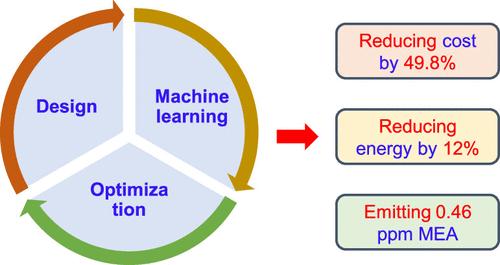当前位置:
X-MOL 学术
›
Ind. Eng. Chem. Res.
›
论文详情
Our official English website, www.x-mol.net, welcomes your
feedback! (Note: you will need to create a separate account there.)
Advanced Designs and Optimization for Efficiently Enhancing Shipboard CO2 Capture
Industrial & Engineering Chemistry Research ( IF 3.8 ) Pub Date : 2024-11-20 , DOI: 10.1021/acs.iecr.4c02817 Dat-Nguyen Vo, Xuewen Zhang, Kuniadi Wandy Huang, Xunyuan Yin
Industrial & Engineering Chemistry Research ( IF 3.8 ) Pub Date : 2024-11-20 , DOI: 10.1021/acs.iecr.4c02817 Dat-Nguyen Vo, Xuewen Zhang, Kuniadi Wandy Huang, Xunyuan Yin

|
Shipboard CO2 capture (SCC) processes face significant challenges, including high costs and the need for extra heating energy to capture 90% of the CO2. Therefore, this study proposes advanced designs and an integration framework using correlation analysis and machine learning-based optimization to achieve the energy- and cost-effective SCC process. Specifically, we develop CO2 capture and ship engine simulators, which are validated and then applied to develop conventional and four advanced designs for the SCC process. Next, a first deep neural network (DNN) model is developed as a surrogate model to precisely predict the performance of the conventional design at low computation cost, serving as the basis for formulating two optimization problems. The optimization results reveal that capturing 90% of CO2 by using the conventional design requires an additional 1.369 MW of heating energy, costing 108.583 $/tCO2. Then, the four advanced designs are analyzed to exhibit their potential for reducing the CO2 capture cost and heating energy, with correlation methods identifying SCC using lean vapor compression (LVC-SCC) design as the most feasible design. Finally, a second DNN-based surrogate model is developed for the LVC-SCC design before being used to formulate the third optimization problem. The optimization results confirm that the LVC-SCC design leverages available heating energy sources to capture 90% of CO2 (approximately 8.89 tCO2/h) at 53.54 $/tCO2, emitting only 0.46 ppm monoethanolamine. Moreover, compared to the conventional design, the LVC-SCC design significantly reduces the cost, heating energy, and cooling energy by approximately 49.8%, 15%, and 12%, respectively. The proposed designs, the machine learning-based optimization approach, and the resulting findings provide valuable solutions for driving the international shipping industry toward achieving net-zero greenhouse gas emissions by 2050.
中文翻译:

用于有效提高船载 CO2 捕获的先进设计和优化
船上的 CO2 捕集 (SCC) 工艺面临着重大挑战,包括成本高以及需要额外的加热能源来捕集 90% 的 CO2。因此,本研究提出了先进的设计和集成框架,使用相关性分析和基于机器学习的优化来实现节能和具有成本效益的 SCC 工艺。具体来说,我们开发了 CO2 捕获和船舶发动机模拟器,这些模拟器经过验证,然后用于开发 SCC 工艺的常规和四种高级设计。接下来,开发第一个深度神经网络 (DNN) 模型作为代理模型,以较低的计算成本精确预测传统设计的性能,作为制定两个优化问题的基础。优化结果表明,使用传统设计捕获 90% 的 CO2 需要额外的 1.369 MW 热能,成本为 108.583 美元/吨 CO2。然后,分析了四种先进设计,以展示它们在降低 CO2 捕获成本和热能方面的潜力,并使用相关方法确定使用稀薄蒸汽压缩 (LVC-SCC) 设计的 SCC 是最可行的设计。最后,为 LVC-SCC 设计开发了第二个基于 DNN 的代理模型,然后用于制定第三个优化问题。优化结果证实,LVC-SCC 设计利用可用的加热能源以 53.54 $/tCO2 捕获 90% 的 CO2(约 8.89 tCO2/h),仅排放 0.46 ppm 的单乙醇胺。此外,与传统设计相比,LVC-SCC 设计显著降低了成本、热能和冷却能分别降低了约 49.8%、15% 和 12%。 拟议的设计、基于机器学习的优化方法以及由此产生的结果为推动国际航运业到 2050 年实现温室气体净零排放提供了有价值的解决方案。
更新日期:2024-11-20
中文翻译:

用于有效提高船载 CO2 捕获的先进设计和优化
船上的 CO2 捕集 (SCC) 工艺面临着重大挑战,包括成本高以及需要额外的加热能源来捕集 90% 的 CO2。因此,本研究提出了先进的设计和集成框架,使用相关性分析和基于机器学习的优化来实现节能和具有成本效益的 SCC 工艺。具体来说,我们开发了 CO2 捕获和船舶发动机模拟器,这些模拟器经过验证,然后用于开发 SCC 工艺的常规和四种高级设计。接下来,开发第一个深度神经网络 (DNN) 模型作为代理模型,以较低的计算成本精确预测传统设计的性能,作为制定两个优化问题的基础。优化结果表明,使用传统设计捕获 90% 的 CO2 需要额外的 1.369 MW 热能,成本为 108.583 美元/吨 CO2。然后,分析了四种先进设计,以展示它们在降低 CO2 捕获成本和热能方面的潜力,并使用相关方法确定使用稀薄蒸汽压缩 (LVC-SCC) 设计的 SCC 是最可行的设计。最后,为 LVC-SCC 设计开发了第二个基于 DNN 的代理模型,然后用于制定第三个优化问题。优化结果证实,LVC-SCC 设计利用可用的加热能源以 53.54 $/tCO2 捕获 90% 的 CO2(约 8.89 tCO2/h),仅排放 0.46 ppm 的单乙醇胺。此外,与传统设计相比,LVC-SCC 设计显著降低了成本、热能和冷却能分别降低了约 49.8%、15% 和 12%。 拟议的设计、基于机器学习的优化方法以及由此产生的结果为推动国际航运业到 2050 年实现温室气体净零排放提供了有价值的解决方案。


















































 京公网安备 11010802027423号
京公网安备 11010802027423号